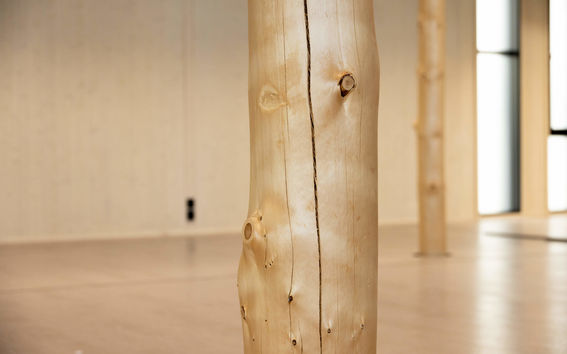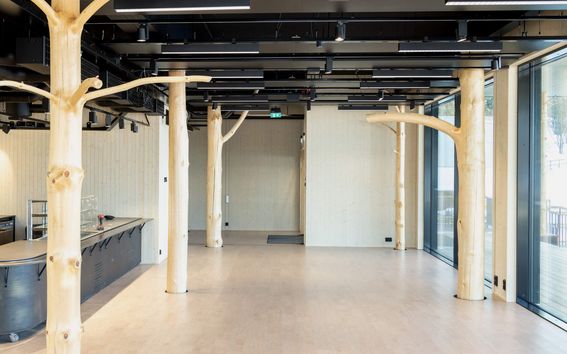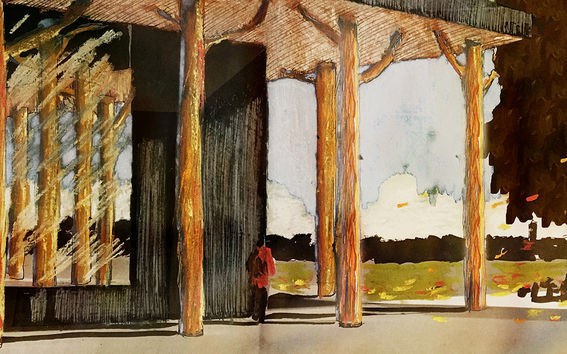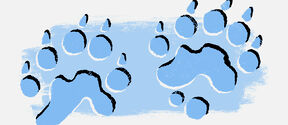Wooden-structured Little Finlandia opened its doors in Töölönlahti Bay

The modular wood structure and its pine pillars are an impressive sight, covering an area of 2 700 square metres. The building stretches from Töölö Bay Park all the way to the shore of the bay in front of its parent structure, the Finlandia Hall.
Its planning got started in the form of a student project arranged in 2019 during a joint wood construction and building design Master’s level course with the City of Helsinki acting as developer. The international course had each of its 18 students design a proposal on their own, with four of these designs selected for further development as group projects. One of the chosen proposals was Jaakko Torvinen’s Finlandia Forest. The design was then refined further by Jaakko Torvinen, Elli Wendelin and Havu Järvelä, and their work made the final pick for construction. The course was instructed by Professors Pirjo Sanaksenaho and Pekka Heikkinen.
The student team continued working on the project as architects in cooperation with Pekka Heikkinen and the firm Arkkitehdit NTR Oy until the building’s completion.
Construction commenced in April 2021 and the building was taken into use in February 2022. It will remain in place for the duration of the Finlandia Hall renovation, which is scheduled for completion in 2025.
From a Loviisa forest to pillars of pine in leafy Töölö
One of the most impressive features and a key design element of Little Finlandia is its 95 pine pillars, all of which were carefully chosen by the architects themselves for various structural support points both inside and outside the building.
“The pine trees were selected according to what was most impressive,” Jaakko Torvinen says.
But construction technical issues were also considered, with the original set of 120 candidates eventually whittled down to 95 of the most suitable individuals.
The trees were logged in Loviisa and processed to specifications by local firm Timberpoint Oy. Branches are typically shunned in wood construction, but they form an important detail in Little Finlandia’s design.
Once Torvinen had, with help from the loggers, selected the most suitable trees, they were cut down and gently de-barked in a way that didn’t damage the wood surface.
“The outer and inner bark were removed with a pressure washer, leaving the tree’s smooth surface intact.”
Some of the pine pillars were delivered to the site pre-attached to large building modules and the rest came as ten lorry loads carefully wrapped in an airy gauze covering to prevent condensation from harming the wood surface.


Materials of nature and industrial elements in perfect harmony
In parts of the building, thick branches extruding from the pine pillars spread over the technology-concealing roof panels like a jungle canopy.
Torvinen thinks this is a fine example of the harmonious utilisation of organic materials and industrially manufactured components: even though it was not possible to measure the trees to millimetre-scale precision, their shapes fit into the surroundings well.
“Thanks to diligent planning, placing the pillars was surprisingly painless,” Torvinen recalls.
Different kinds of wood materials have been used extensively in the building. Its walls are made of cross-laminated timber, the interior walls are covered with spruce panels and the flooring is made out of cork.
The building is designed to be adaptable. Constructed from wooden modules, it can be dismantled and relocated to serve in another capacity, most likely as a school or daycare centre. Its useful life is expected to be 20-30 years.
The future of Little Finlandia is clear, but the just-graduated architect’s own plans remain open for now.
“Continuing with wood construction is my dream. First-stage design is often limited by consideration of whether or not something can be realised. I want to turn this thinking around. Let’s start with unlimited ideas and then think of ways to realise them in practice.”
Like it was with Little Finlandia – it all started with a pine idea.


Little Finlandia opened to the public at the beginning of March. Little Finlandia will bring a comfortable living room open to all in the Töölönlahti Bay area. The space will contain for example café and a terrace open to everyone.
Read also
Text: Annika Artimo
Photos: Mikko Raskinen
Sketches: Jaakko Torvinen
This article has been published in the Aalto University Magazine issue 30 (issuu.com), April 2022.
Read more news

Finland’s smallest large carnivore seeks new forests – remote sensing supports wolverine conservation
Satellite data and snow track surveys reveal that wolverines have returned to Southern Finland. While the national population is growing, the species remains endangered. A new study sheds light on the forest environments that support its survival.
Student innovators seal a new future for silicone
The Product Development Project course pairs multi-disciplinary student teams with industrial partners to find sustainable solutions to real-world problems.
Everyday choices: Talvikki Hovatta, what is a relativistic jet?
Senior Scientist Hovatta explores the mysteries of the universe at Aalto University’s Metsähovi Radio Observatory.






